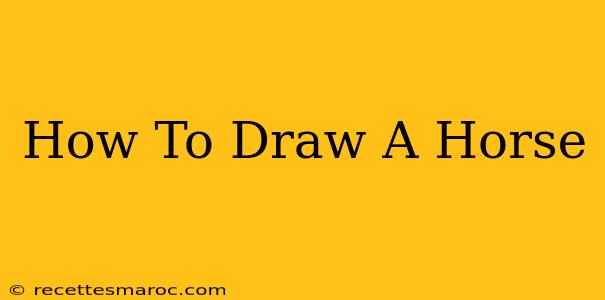Learning how to draw a horse can seem daunting, but with the right approach, it's a rewarding challenge for artists of all skill levels. This comprehensive guide breaks down the process into manageable steps, providing tips and tricks to help you create realistic and dynamic equine artwork. Whether you're a complete beginner picking up a pencil for the first time or an experienced artist looking to refine your technique, this guide will equip you with the knowledge and confidence to draw magnificent horses.
Understanding Horse Anatomy: The Foundation of a Great Drawing
Before you start sketching, understanding the basic anatomy of a horse is crucial. This isn't about becoming a veterinarian, but rather grasping the key proportions and shapes that define a horse's form. Focus on these key areas:
- Head: The head is relatively small compared to the body. Pay attention to the shape of the muzzle, eyes, and ears. Practice drawing these features separately before integrating them into the complete drawing.
- Neck: The neck is long and muscular, connecting the head to the shoulders. Observe how it curves and flows.
- Torso: The body is deep and powerful. Note the rib cage, the placement of the legs, and the gentle curve of the back.
- Legs: Horse legs are long and slender, with distinct joints and muscles. Study the way the legs bend and how the hooves are attached.
- Tail: The tail is long and bushy, providing balance and expression.
Tip: Use reference images! Find clear photographs or even videos of horses in various poses. This will help you understand the nuances of their anatomy and movement.
Step-by-Step Guide to Drawing a Horse
Let's walk through the process of drawing a horse, focusing on simplicity and accuracy.
Step 1: Basic Shapes
Begin by sketching simple shapes to represent the horse's main body parts. Think of a circle for the body, an oval for the head, and elongated rectangles for the legs. Don't worry about details at this stage – just get the overall proportions right.
Step 2: Refining the Form
Connect the basic shapes, smoothing out the lines to create a more refined form. Start to define the neck, the curvature of the back, and the musculature of the legs. Think about the horse's posture – is it standing still, running, or grazing?
Step 3: Adding Details
Once you're happy with the overall form, start adding details. Sketch in the eyes, nostrils, and mouth. Define the muscles of the legs and the shape of the hooves. Add the mane and tail, paying attention to their texture and flow.
Step 4: Refining Lines and Shading
Go over your lines, refining their thickness and smoothness. Use shading to add depth and dimension to the drawing. Observe where the light hits the horse and where the shadows fall. This will bring your drawing to life.
Step 5: Erasing Construction Lines
Gently erase the initial construction lines, leaving behind a clean and polished drawing.
Tips for Drawing Horses in Different Poses
Drawing horses in motion adds dynamism to your artwork. Here are some tips:
- Galloping Horse: Focus on the powerful extension of the legs and the flow of the mane and tail.
- Running Horse: Capture the sense of speed by exaggerating the stretch of the legs.
- Standing Horse: Pay close attention to the weight distribution and the subtle curves of the body.
Mastering Horse Portraits: Eyes and Expressions
The eyes are the windows to the soul, and this is especially true for horses. Capturing their expressions adds character and emotion to your drawings. Practice drawing different expressions, from calm and serene to alert and watchful.
Beyond the Basics: Exploring Different Styles
Once you feel comfortable with the basics, experiment with different styles. Try drawing horses in a realistic style, a cartoon style, or even an abstract style. The possibilities are endless!
Practice Makes Perfect: Your Journey to Mastering Equine Art
Drawing horses is a skill that improves with practice. Don't be discouraged if your first attempts aren't perfect. Keep practicing, experimenting with different techniques, and referencing images. With dedication and patience, you will see your skills develop and your equine artwork flourish. Remember to have fun and enjoy the creative process!

